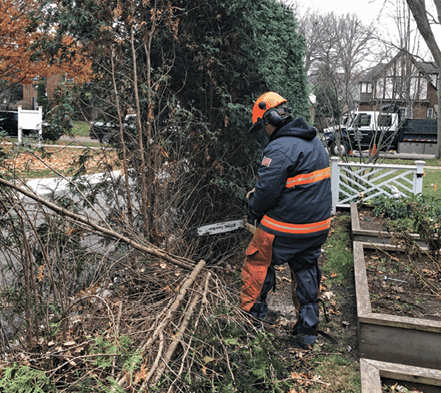Keeping crews safe and job sites accident-free are the top priorities for every landscape company, but achieving a safety culture is front-of-mind with every employee just happens on its own.
Building a safety culture takes the intention and requires routine safety meetings, standard safety protocols and management and leadership teams that take safety seriously.
To glean tips for establishing a safety-first mentality, Lawn & Landscape spoke with three companies who have won national awards for their safety records – Clarence Davids & Company, with multiple locations serving the Chicago area; Mahoney Associates, and Southampton, New York; and Snow & Sons Tree & Landscaping in Greenfield, Massachusetts.
- Standardize Crews’ Safety Equipment.
To ensure crews have the safety equipment they need, Mahoney Associates provides each team member with a standard safety starter kit, which includes reflective elements, ear and eye protection, as well as high-visibility jackets for the winter, says Michael Maskiell, Mahoney’s lawn care division manager. Crew members are also asked to sign a document acknowledging receipt of safety wear – both for insurance purposes but also to signify that they agree to commit to wearing them.
Mahoney also has standardized safety equipment installed on every crew truck, including a first-aid kit, a fire extinguisher and even a card with pertinent safety information. “Taped to the back window of every truck is a safety card with 911 as well as the phone number and address of the local hospital, walk-in clinic, and Chemtrec – if there is chemical exposure,” says founder Don Mahoney.
- Prioritize On-the-Job Safety Training.
At Snow & Sons, much of the safety training surrounding equipment use is done on-the-job, with foremen and other leadership personnel modeling best practices for new hires and those less familiar with the tools. It starts with basic training at the office – how to use the equipment safely and get the desired result and what to watch out for when working on a job site.
Employees then practice using the equipment at the office before working with crews on a job site. “With equipment, going to show employees how to run it, what you need to look out for and how to get a good job,” says manager Kyle Snow. “When dealing with chainsaws and hedge trimmers, in particular, we try to outline possible problem scenarios that could cause injuries.”
Mahoney Associates frequently supplements its internal staff safety training with workshops provided through other, outside sources – including industry associations and the company’s own insurance company.
“Our insurance company sent someone in five hours of training to get our team certified on lifting, doing defensive driving, proper lifting, and cold-weather exposure training,” Mahoney says. “Once we reached out, we learned they had this massive catalog of safety programs – some we could implement ourselves, and others where they could send someone in.”
- Hold Regular Safety Meetings.
At Clarence Davids & Company, all staff members attend full-day safety training just before the spring busy season and again before the winter snow removal season.
“Everybody comes in, and we have numerous bullet points that we go over, whether it’s driving (safety) or information on new pieces of equipment, or any new regulations that have gone into effect,” says President Bill Davids. “We always do the same for snow, with driving and plowing safety during the winter.”
At Mahoney Associates, safety meetings are held weekly or bi-weekly, depending on the work level of the season. But safety lessons advised tabled only until meeting time; management and foremen use every workday as an opportunity for training.
“At these meetings, we discuss issues and concerns focusing on safety, review safety procedures, and discuss equipment (protocols),” Maskiell says. “Also, while out of the field, doing safety inspections with workers and mentoring them on why safety is important – why it is important for them to wear their safety equipment and how it benefits them.”
- Document Mistakes and Reward Success.
Along with its spring and winter safety training, Clarence Davids also has an annual, company-wide fall safety meeting, during which employees with positive safety records are publicly recognized and awarded with sweatshirts or other company gear. Employees are also eligible for twice-a-year paycheck bonuses based on maintaining a clean safety record.
When incidents occur, the issue is carefully documented and a crew foreman goes over the mistake with the team member.
“Each accident is written up, and is gone over by the supervisor and the employee,” Davids says. “Then when we pay out bonuses, they get a sheet that shows their record, either clean or the date of the incident and what it was.”

